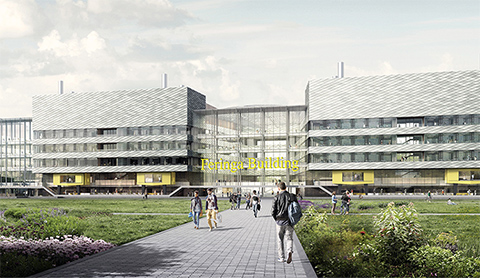Two companies involved in the plans – Ector Hoogstad Architecten and consulting agency Dukers & De Cock – confirm that a contractor has been found. RUG spokesperson Jorien Bakker has confirmed that the contract negotiations are nearing an end.
The Feringa Building will be replacing the facility at Nijenborgh 4, which is out of date and has been having an increasing number of issues. On top of that, the faculty is expanding, which means it’s increasingly difficult to house students and staff.
The new building will have to house approximately 1,400 students and 850 staff in 62.000 square metres, or twelve football fields. It will be outfitted with the latest vibration free laboratories and was originally meant to be available for use in 2022. It’s unclear whether that date still applies.
Terminated
In July 2017 the university reported that the tender process had been terminated. The improving economy was wreaking havoc. The boom meant that contractors had their hands full. This has led to enormous staff shortages; in the second quarter of 2018, there were more than 16,000 job openings (source: CBS). ‘Continuing the tender process will lead to an unbridgeable gap between the project budget and the contractors’ expected tender prices’, the faculty said at the time.
The Science and Engineering faculty board, which will also be housed in the new facilities, decided to explore the options to cut costs. Construction consultancy firm Dukers & De Cock performed this ‘second opinion’, as it was called at the time. In September, the RUG announced that the ‘labs, offices, and educational spaces were left out of the considerations for adjustments’.
‘In consultation with the design team we’ve drawn up smarter product specifications that are more cost-efficient to the university without sacrificing the reliability of the products. The entire design has been tested for this and adjusted where possible’, the RUG said. The sustainability and antiseismic design from the original plans have been preserved.
Difference
The biggest difference was moving the building eighty metres to the south, allowing construction to take place ‘all at once’. Earlier, the Feringa Building was to be built in two difference phases. The southern part should have been constructed over the past year, with the northern part being done in 2021.
Staff at Science and Engineering are happy that their new building is finally on the horizon. ‘We’ve been getting pretty impatient around here, so unless they announce the plans and schedules soon we’re bound to lose faith in the whole endeavour’, says research technician Arjen Kamp.
Hanne Bosch, president of study association De Chemische Binding, is happy as well. ‘This is definitely good news.’ The association will probably not have the most modern facilities in the new building. ‘We need an office, a storage room, and a place for our members to congregate. We’re spread out now, but everything will probably be in a single room in the new building. One of my predecessors from several years back was involved in those plans.’




